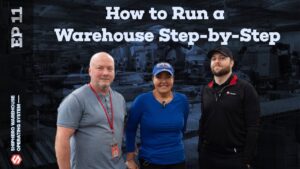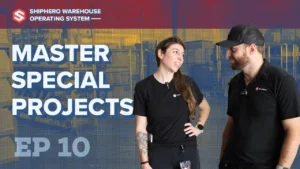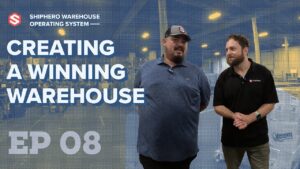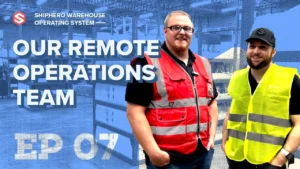Video Transcript
As warehouses grow, people, process, and priorities start to collide and it gets really messy. You end up in a situation where your customer service team feels like the warehouse is not doing what they need. The warehouse team feels like they're getting ran all over the building. They don't know what to prioritize, they don't know what to work on. You end up with frustrated team members pointing fingers, and customers suffer as well. It's not the fault of the customer service team and it's not the fault of the warehouse team. It's actually a structure that you can improve and we're going to talk about that today. With me is Kristian, one of the smartest people here at ShipHero. We've worked together for four years. She created the idea of what we call WAMs, and she formed a team and she now leads the team of eight. Kristian, what is the problem that caused us to create the WAM team and what does WAM stand for?
Yeah, so WAM stands for warehouse account manager. We created this team because before managing the WAM team, I was managing the customer service team. Like Aaron said, a lot of the frustrations that were experienced, we were also experiencing, where we weren't getting the right answers or answers as quick enough to close the loop on any issues or questions that we were getting from our clients from the warehouse. Again, not the fault of the warehouse, but they have so many things going on on the floor, and so we wanted to really provide visibility to our CS teams and our other fulfillment teams of the warehouse, without really causing any type of distraction.
That way, all the teams on the floor are able to really focus on what they have to do day to day. These small little tasks, questions, issues that happen, we have one dedicated person at each one of our facilities to just tackle that, kind of take that off of everyone's plate. Then, we work internally with our engineers, with our sales team, with our onboarding team, with any of the teams that we would need to bring in to help resolve any issue, we would end up doing ourselves, taking away that stress from the warehouse. That's how the WAMs came to be, and it's grown so, so much from the moment we started and it's been such a benefit, I feel, across any of our facilities.
Before, the way it would often work is there would be a customer whose order maybe didn't ship because the address didn't validate, so the order was sitting in a tote. For our brand that we serve, it was a super urgent order that needed to go out. Customer service would try to find someone in the warehouse, typically the warehouse manager, tell them, "Hey, can you find this tote and get it shipped?" Which means the warehouse manager is now spending 20 minutes sorting through totes trying to find the problem reactively to help that customer out. That means for those 20 minutes, that warehouse manager is not doing his or her job, and his or her job is to manage the floor, manage the people, and manage the flow of orders. They're not doing that. They're serving one customer. Now, we have a warehouse account manager who has a dedicated role. Let's talk about, what are the responsibilities and what's the day-to-day of a warehouse account manager?
What our WAMs do day to day is we tackle anything that requires troubleshooting. A good portion of that day is working through trouble totes. A trouble tote can have any error. It could be an address error, it could be a shipping carrier error, it could be that the product itself doesn't fit comfortably in a regular multi item batch tote. At that point, we're working now with our automations team, making sure that the automation is sending that order to our custom station. There's multiple aspects of just working through trouble totes alone where we have to not just work through it ourselves, but we will pull in other teams, our engineer to work on any technical issues. We will shoot some messages out to our clients just to confirm if the packaging is correct. If the account has a CSM, we'll reach out to the CSM, loop them in on any issues that we're seeing on the floor.
We also work through any shipping plans. Any inbound shipping plans that come in that are non-compliant, one of the things that we want our receiving teams to not have to worry about. They did their job by identifying that the shipping plan does not fit what we would normally consider compliant. They slap a label on it that lets us know that this is a non-compliant shipping plan. We use our Monday board to help organize and manage that queue. Then we're on the floor, so we can easily walk over to our receiving area, look at the shipping plan, maybe take some photos, anything that we can share with the client or with the CSM to express to them what needs to change, why this is noncompliant, why we're now delaying the process of receiving in. If at any point in time, let's just say some products need bar coding or bagging, we'll move it over to special projects, they'll take over at that point.
It's a lot of looping in other teams, really just making sure that we're communicating everything that we're seeing on the floor to other teams, our clients, CSMs, and just making sure everyone is fully aware of what's happening on the floor. We have the inventory team bringing some things to us as well. Inventory that has, again, the wrong barcode. It could be inventory that they need to just find out what client it's for. Multiple issues that come up. We like to say that we're kind of like the eyes of fulfillment on the floor. We want to make sure that any and everything that we are seeing that needs some type of solution, that we're bringing it up and just making it known to everybody.
We like to work in two parts, so we're very reactive. Totes, for example, is very reactive. We want to make sure that this order goes out the door regardless of the blocker that we've come across. But at the same time, after we've gotten that order out the door, we are also looking at the order very granular and trying to pick and choose little things that need to get improved so that we're working with automation, we're working with the CSM, and making sure that these types of orders don't come back into our hospital. At that point, now we're being proactive. It's a lot that goes on during the day, but I feel like a lot of our team is just go, go, go all the time. We're really just trying to help solve all the issues on the floor every day.
There's two ways that the WAMs actually reduce the total labor spend in the warehouse, and Kristian hit both of those. One is the proactive part. The previous state would be there would be a product that doesn't fit in a tote, and that would get fixed 30 different times on 30 different orders. Now, the WAM has the time and takes that, finds what the issue is, changes the rule so it goes into a different size tote, and now we don't have that problem again. When I say 30, we all know in a warehouse it could have been 300 times before someone actually jumped in.
The second way they're a force multiplier is keeping everyone in flow. The idea is basically, if you're packing and you need to think, you hit the hospital button and you give it to the WAM. That's their job. Your job is to keep packing at your 50 orders an hour. We see, once we interrupt people and they're doing their 50 an hour, and they have to take a five minute break to fix something, it takes them another hour to get back up to speed. Now they just keep moving, so they get much faster. Same thing for the receiving team. If there's non-compliant, they keep going. They push it to the side and they keep going, and they stay in their flow where they're most efficient.
For the WAMs, their flow is problem solving. Even though they're jumping between a lot of different problems, and it's a certain profile that we're going to talk about that makes a really good WAM, but still, they're always in that flow. They're never packing a standard order. They're always in the flow of, what's the problem? How do I fix it? They're in problem solving mode for eight hours a day, and they're amazingly effective at getting through a large list of problems that everyone everywhere else has and keeping the rest of the team moving. You've hired or promoted all the WAMs. Right?
Yeah.
What do you look for a new WAM hire?
Number one, we ultimately always want to promote from within. We've found that promoting from within has really helped this person come into this role already understanding a lot of the flow of their warehouse, their 3PL. Granted, we've standardized a lot of things across all our facilities, but every facility still has their certain flow. If we're promoting from within that facility, I know that I'm not changing anything in what they're understanding should be happening across the floor. A lot of the WAMs that we've hired have been outbound supervisors, which we have found are great because they are familiar with all the different types of flows across the floor.
We have receiving leads, we have inventory leads, and then two of our WAMs were lead packers, which is awesome because what happens also at the day-to-day is that, although there's one person at each one of our facilities, we're hundreds of miles away from each other. We still come together in Slack. It could be a Slack channel. Sometimes it's just a Google Meet, and we're all talking about different things that we're seeing on the floor. One of the biggest things that I've noticed most recently is that, now that we're a well-oiled machine, because we're only a year old, if there's any issue at one facility, say we're experiencing an issue at a pack station, an error, the first move that they do is not necessarily post it to our engineer.
They post it in our WAM channel and they tag all the WAMs. They ask everyone, "Are you also experiencing this?" If they are, they do it on their own and they'll choose one person to report it to engineering, and then all the WAMs gather examples from their facility and send it over to our engineering team. I have found that we've been able to resolve so many issues that are facility-wide affecting packing, affecting orders going out, that have been resolved within 10, 15 minutes. A lot of that, especially during say peak season, is going to be super beneficial in just troubleshooting and getting errors resolved super quickly so that we're not causing too much of a blocker in getting orders out the door.
I find that, again, outbound supervisors, really just promoting from within someone who's a little more seasoned, I'd say maybe someone who's been with you at least six months and really understands what the expectations are of the warehouse, I think would be an ideal candidate, and someone who's really good with multitasking. We want to make sure that someone is able to really self-manage themselves on the floor, and just be able to tackle everything they need to tackle across different divisions on site and leave the door with nothing left behind. We want to make sure that everything's done before the end of day.
For us, WAM's a really elevated role. Kristian ran the entire CS department before she moved into creating this role a year ago, and it's been usually beneficial to how we ran as a team. Customer success or customer service now does way better because they have the tools and the information and the person on the ground to help them get their job done. Let's say you've identified a good candidate who's good at multitasking, who likes problems, who likes moving around the warehouse. How do you train them up?
We do like to include the very first week, it's all software. It's all software driven. We want to make sure that, yes, you've been with ShipHero say a year, you've been in this warehouse for a year, you understand the flow. But as a WAM, now we're hopping into client accounts, in and out of them. We're understanding automations, we're understanding multi-warehouse allocations. We're really trying to understand the makeup of the client's account to really understand their product on the floor and how the shipments should be going out the door, if there's any settings that we're seeing for the client. That's that one week of software is just very software driven, is going to be crucial to really understanding how to hop in and out of accounts, and then just understanding how orders are set up for each client.
Then after that, we do two weeks of shadowing. Two weeks of shadowing. It could be shadowing either remotely with another WAM, or if that facility already has a WAM for say first shift, they'll stay on first shift with them for those full two weeks and really, really get the nitty-gritty of what they do on a day-to-day basis so they're fully prepared for week three to start on their own. Then we have full support. We share Slack. I mean, we have Rob in there. We have a lot of ops people as well that are there to help the WAMs if there's any issues that pop up in general.
Yeah, it's a super collaborative team.
Yeah.
What's next for the WAM team?
One of our main focuses has been just making sure that we're growing the team enough to cover the shifts. We have some facilities now that have that second shift. It was one of the pain points that we did experience where they were like, "We only have a WAM for the first shift and have all these benefits for that first time of the day, that we might need it for the second." That's one of the initiatives we've been working on too, just making sure we have that coverage so that nothing gets missed, especially at night when we have some packers packing out orders that could experience some errors, things like that.
Training. Training is always something that we want to do on a day-to-day. New things change, new things come up with the software, new versions, new processes for the pack stations, for the pickers, for everything that happens. I just want to make sure that the WAMs are up to speed on any changes and flow. We want to make sure that if the warehouses have questions about any new changes, that they're able to go to the WAM who is physically on site and they can ask these questions and just reassure them that this is the process, or we can have the warehouse relay any issues to frontline.
Frontline is also a new process or a new team that we started working on, which the WAMs are very much involved in as well. It's made up of our central operations team. It's probably a group of six or seven of us, and generally it's for support for the warehouses. It's additional support, additional remote support for the warehouses in addition to the WAMs that we have physically on site. What we ultimately want to do, frontline is again a resource for our warehouses, our GMs, our supervisors, to really express any issues that they're experiencing on the floor. Technical for the most part, where the WAMs may not be the right resource for them, so they'll hand it over to frontline. But, if frontline needs visual on anything on the floor, they'll go ahead and they'll loop in the WAM as well.
We're really full circle here on making sure that we're covering all aspects of any troubleshooting, any issues, any questions, any doubts that the warehouses have so that we're fully covered. I think this is going to be super beneficial for the warehouses come this peak season. I think we've never had this type of coverage before, something that's so centralized and focused for our warehouses. I think it's going to be a game changer on how we resolve our issues and how quickly we can get things rolling so that there's less interruptions on the day-to-day.
The way frontline interacts that's helpful is when there's issues that are best handled on a computer. Let's say we're not sure why order shipped from a given warehouse. That's really not the WAM to go in and look at the rules and try to understand it. They can, but it's better for remote ops to go sit at their couple of computers, dig into it, see what the rules are, maybe why was it change, and do that research. Then they'll reach out to the WAM and say like, "Oh, actually the reason it didn't go from your warehouse is because we actually don't have enough pickable stock. Can you go check that location and see why there's no pickable stock?" That's where they pull back the WAM, but we try to make it so that the WAM is definitely very technical, but they're still doing things that require being onsite, versus the remote team just with laptops. You've just got your couple of monitors up and you're just working there, and you're using your WAM as your hands and eyes on the floor.
Right.
Anything else people should know if they're considering adding a WAM to their team or why they should add a WAM so their growing warehouse?
I think every warehouse should look into having a WAM, or a role that's similar to this type of support. I think it's only beneficial to those on site. This is going to be a person who understands the end goal for every single department on the floor. They're a team player. They understand the trials and tribulations that happen on a day-to-day basis, and they're going to be able to help support you at your warehouse or any of GMs, managers, anybody on site, and really help close the loop on a lot of issues, and again, be proactive at resolving these things so that you don't have to deal with them again. I think if anything, having a WAM or someone with a similar role at a facility would be beneficial, just in general.
Why is it important when hiring a new WAM or promoting a new WAM that you take someone who is already experienced and familiar with the ShipHero software?
A lot of what we do to troubleshoot, it can get pretty technical. We want to make sure that this person understands, one, the order flow, how it comes into our system. We want to be able to understand how automations are set on this order, who set the automations, and understanding them. We will end up looking in on the client account, seeing how the automation was set up. We don't necessarily modify anything at that point. We end up working with our automations team. But, understanding the way that the automation was set up can really help us determine, this needs to get updated. Right? This is why all these orders are coming to this pack station incorrectly, and so we can report it more accurately.
Same goes for multi-warehouse allocations. Since we have multiple warehouses that share the same inventory, we want to make sure if, say, a CS team member reaches out to us and says, "Why was this order partially shipped from your facility, and I still see some there that was not fulfilled?" We can understand the multi-warehouse allocation rules. We know where to find it, we know how to read it. The same goes for just looking at an order page and understanding what to look for, all the little details that really affect the order and whether it's ready to ship, whether it's pickable. We want to understand how to read the inventory when we're looking at a product and say, "Oh, we have 500 units of it in overstock. Why is it not allocated now to this order? Why has this order not gone out?"
There's a lot of little nuances that the WAM really needs to fully understand as far as the software goes, which is why we have found someone who uses the software daily, maybe just for packing or maybe just for inventory, is a benefit already because they're very familiar with the software already. Training them on maybe other tabs that they didn't know existed, it's super easy. It's a very easy transition and it's something that I think anyone who is comfortable with the software already can transition to flawlessly.
Our results have been, definitely play that out, which is having a WAM has definitely improved our performance. I would recommend you consider it and see if there's a need in your organization, and there probably is. Then I'll just say, thank you Kristian, appreciate it. I encourage everyone to check out our other videos in the Warehouse Operating System. I think there's a lot of knowledge there to help people scaling up their warehouses. Learn from some of our mistakes and learn from some of our learnings, and make your warehouse go from good to great.



